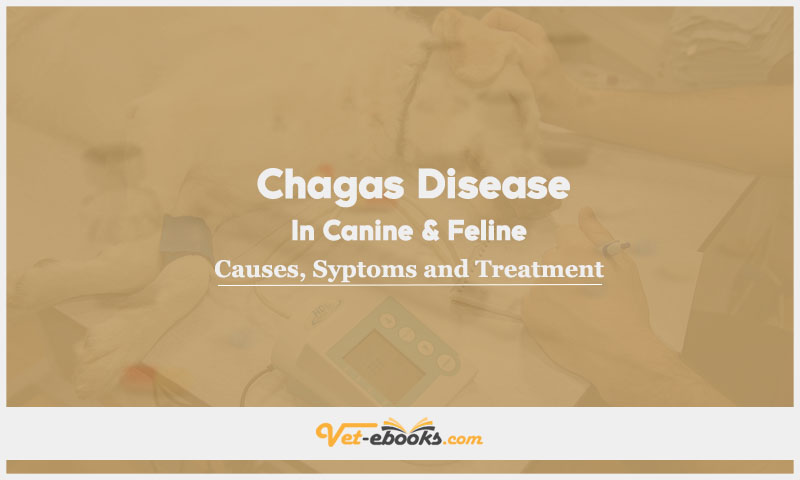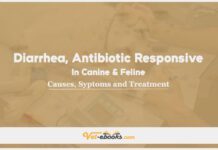Chagas Disease (American trypanosomiasis) In Canine and Feline: Causes, Symptoms and Treatment

Overview
Chagas disease, also known as American trypanosomiasis, is a systemic protozoal infection that affects dogs and cats. It initially manifests as acute myocarditis and can progress to chronic dilated cardiomyopathy, sometimes leading to neurological symptoms.
Causes of Chagas disease (American trypanosomiasis) In Canine and Feline
Causes
Chagas disease is caused by a protozoan parasite called Trypanosoma cruzi. Transmission can occur through various routes, including contact with the feces of the Reduviid (or “kissing”) bug, ingestion of the bug vector, blood transfusion, or vertical transmission from mother to offspring.
Risk factors
The primary risk factor is living in or traveling to endemic areas.
Pathogenesis of Chagas disease In Canine and Feline
- Trypanosoma cruzi is a zoonotic hemoflagellated protozoan that is transmitted through the feces of vectors, specifically the Triatomina protracta and Triatomina sanguisuga bugs, also known as “kissing bugs.”
- In dogs, infection can happen in several ways:
- Ingestion of infected vectors.
- Entry of the parasites in the feces of the vector through a bite wound or mucous membrane.
- Transmission via blood transfusion.
- Vertical transmission to offspring through transmammary or transplacental routes.
- Upon entry, the protozoa multiply intracellularly at the site of infection, leading to parasitemia, characterized by the presence of trypomastigotes.
- These parasites then invade cardiac myocytes, where further rounds of multiplication, cell rupture, and subsequent increase in parasitemia coincide with the development of acute myocarditis.
- The peak level of parasitemia typically occurs between 14 to 21 days post-infection. As the body’s immune response strengthens, parasitemia levels decrease while antibody titers against the protozoa rise.
- Subpatent infection, where the infection is not detectable, can occur around 30 days post-infection.
- Dogs that survive the acute myocarditis phase enter a protracted asymptomatic stage, which may gradually progress to end-stage dilated cardiomyopathy in some cases, usually within 1 to 5 years.
Symptoms (History & Physical Examination) of Chagas disease (American trypanosomiasis) In Canine and Feline
History
- Dogs of any age and breed are susceptible to this disease:
- Acute infections tend to be more severe in dogs younger than 2 years old.
- Chronic infections are typically seen in adult dogs.
- Sporting breeds and dogs that live outdoors are at a higher risk of coming into contact with disease vectors or reservoir hosts.
- In the case of cats, there is more recent evidence of infection and associated organ pathologies.
Physical examination
Acute Myocarditis (Sometimes Accompanied by Encephalitis)
- Sudden death
- Lethargy
- Depression
- Weakness
- Difficulty tolerating exercise
- Fainting
- Enlarged lymph nodes
- Paleness in mucous membranes
- Slow capillary refill
- Both left- and right-sided heart failure, characterized by a rapid heart rate along with reduced QRS complexes and extended P-R intervals (indicative of heart block
- Neurological symptoms like weakness, ataxia, involuntary muscle movements (chorea), and seizures
Chronic Dilated Cardiomyopathy
- Weakness
- Difficulty tolerating exercise
- Syncope
- Occasional sudden death
- Ventricular tachycardias
Diagnosis of Chagas disease (American trypanosomiasis) In Canine and Feline
1- From History and Physical Examination
2- Diagnostic Procedures
ECG (Electrocardiography)
- Supraventricular and ventricular arrhythmias, atrioventricular block (of any degree), and bundle branch block may be observed.
- Ambulatory ECG (Holter) can be used to document abnormalities.
PATHOLOGICAL FINDINGS
Acute Phase:
- Diffuse granulomatous myocarditis
- Myocardial necrosis
- Parasitic pseudocysts with intracellular amastigotes
Chronic Phase:
- Lymphoplasmacytic inflammation
- Loss of myocardial fibers
- Severe interstitial fibrosis
- T. cruzi amastigotes may be found in the heart, lymph nodes, liver, spleen, and brain.
CBC/BIOCHEMISTRY/URINALYSIS
Usually within normal limits.
OTHER LABORATORY TESTS
- Cardiac troponin I levels may rise, indicating myocardial damage.
- Serological tests can confirm T. cruzi serum antibodies (typically present around 16 days post-infection), but their presence doesn’t necessarily indicate clinical disease. Note that these tests can sometimes cross-react with Leishmania.
- Trypomastigote (blood form) may occasionally appear in blood smears, lymph node aspirates, abdominal effusions, or the buffy coat during periods of high parasitemia.
- Amastigote (intracellular form) can be identified in lymph node aspirates or impressions.
- Polymerase Chain Reaction (PCR) can detect parasite DNA in blood or tissue with high specificity, but it may have low sensitivity in the chronic stage when parasite levels are low.
IMAGING
- Thoracic radiography may reveal cardiomegaly, pulmonary edema, or pleural effusion.
- Echocardiography can show heart chamber dilation and systolic dysfunction.
3- Differential Diagnosis
- Heart muscle problems, congenital heart conditions, myocarditis due to injury
- Distemper, Neospora species, toxoplasmosis
Treatment of Chagas disease (American trypanosomiasis) In Canines and Felines
General
- There is currently no approved treatment for T. cruzi infection.
- Management involves addressing heart failure as outlined in the guidelines for congestive heart failure in both left-sided and right-sided cases.
- For tachyarrhythmias, anti-arrhythmic medications may be considered, while bradyarrhythmias may necessitate pacemaker implantation.
- Severe acute myocarditis combined with high parasitemia, the prognosis is unfavorable, and there is an increased zoonotic risk, particularly to individuals handling blood products. In such cases, euthanasia should be contemplated.
- If dogs do manage to survive the acute phase of the disease, the transition to the chronic stage tends to happen more rapidly, typically within 1 to 2 years, in dogs diagnosed at a younger age (less than 2 years old) compared to those diagnosed at an older age (over 4 years old), who tend to have a longer survival period (3 to 5 years).
- The approach should focus on the specific treatment of cardiac failure and arrhythmias.
- Testing housemates or littermates of infected dogs is advised.
- Taking steps to eliminate the insect vector, such as removing brush and using pyrethroid insecticides, is crucial.
- Owners should be made aware of the potential zoonotic risk and the possibility of sudden death.
- Infected females can transmit the infection to their offspring.
- Cardiology tests, including ECG and echocardiography, can identify dogs at risk of developing clinical signs or experiencing sudden death.
Medications:
Acute Stage
- Benznidazole (Ragonil; Roche SA): The preferred drug, known to achieve cures in both humans and dogs.
- Nifurtimox (Bayer 2502 or Lampit; Bayer AG): When combined with corticosteroids, it may help eliminate parasitemia and improve survival rates (refer to Table 24-1).
Chronic Stage
- Neither nifurtimox nor benznidazole demonstrate efficacy in the treatment of the chronic stage of the disease.
- Cythioate (Proban) is effective in reducing vector populations, while Fipronil Spot-on (Frontline Top Spot; Merial) has been found to be ineffective in preventing reduviidae bugs from feeding on dogs.
Some Notes:
- Nifurtimox is often associated with common side effects that typically limit treatment to 3-4 weeks. These side effects include anorexia, vomiting, weight loss, central nervous system (CNS) signs, polyneuritis, pulmonary infiltrates, and skin eruptions.
- Benznidazole tends to have fewer side effects compared to nifurtimox, with vomiting being a less frequent occurrence.
- Regarding zoonosis, transmission to humans can occur through accidental injection of infected blood into a person.
- When a kennel of dogs is infected, investigating the mode of transmission is crucial to identify and block the source of infection.
- In cases of chronic disease, the organisms may be challenging to identify through histopathological examination of cardiac tissue. This may necessitate the use of immunohistochemistry or tissue PCR for accurate diagnosis.
- Serum antibody titers often remain detectable despite drug treatment, although it has been reported to decrease in humans treated with benznidazole.
Do You Want To Increase Your Veterinary Knowledge and Practical Skills?
You Can Now Browse and Download +3000 Books For Veterinary Professionals & Students Online.
Download Veterinary Books
















